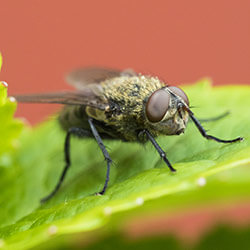Identification
- Colour Dark grey
- Size From 8 mm to 10 mm long
- Description Have golden or yellowish hairs on their thorax, while their abdomen features a black and silver checked pattern. Their wings overlap across the abdomen when at rest.
- Notes Cluster flies strongly resemble house flies, but are larger, darker, and slower.

What Do Cluster Flies Look Like?
Cluster flies appear similar to the common house fly and blow/bottle flies. Adult cluster flies are dark grey in colour, measuring around 8 to 10 mm in length, and have numerous golden or yellowish hairs on the thorax. The abdomen of a typical cluster fly features a black and silver checkered pattern.
Despite bearing a strong resemblance to house flies, cluster flies are larger in size and darker in colour. They lack the dark stripes found on the thorax of house flies and the metallic-coloured shining bodies of bottle flies. They are sluggish in movement compared to house flies and bottle flies. The wings of cluster flies overlap across the abdomen when the insect stands at rest.
Habitat, Life Cycle and Diet
Habitat
Cluster flies are very active in the summer months, which is when they reproduce. They spend their first few weeks of life underground before emerging from the soil as full-grown adults. As colder weather approaches, they seek out warm, interior spaces for hibernation during the winter months, which is typically when they start to appear indoors.
Where do cluster flies come from?
Cluster flies can be found in Europe and North America. Adult female cluster flies lay their eggs in cracks in the ground near earthworm burrows. After hatching, the larvae move beneath the soil and enter the bodies of the worms, where they feed for approximately 2 to 3 weeks before pupating in the ground, a process that takes another 11 to 14 days.
Life Cycle
Similar to other flies, cluster flies develop by undergoing a complete metamorphosis from egg to adult. They emerge to mate after the winter, and the females lay eggs in the soil during the spring. It is estimated that a female cluster fly will lay eggs 4 times per year, and approximately 130 eggs each time.
Larvae, which hatch from the eggs in around 3 days, are cream-coloured and have an elongated wedge shape. Shortly after hatching, the larvae seek out earthworms to bore into and use for sustenance until they’ve completed development. This process lasts for about 2 to 3 weeks before the larvae pupate. Cluster fly pupae mature into fully developed adults in approximately 11 to 14 days.
How Long Do Cluster Flies Last?
The entire life cycle of a cluster fly generally takes four to six weeks to complete. However, by invading and overwintering indoors, a cluster fly infestation can persist for several months and continue to be a nuisance until proper removal measures are implemented.
Diet: What do adult cluster flies eat?
Cluster flies are a unique type of pest compared to other flies. Their feeding habits revolve around plant sap, flower nectar, and fruits, which they easily access due to their ground-based lifestyle. Cluster flies prefer to hibernate throughout the winter and will often enter homes through a door or window crack. They’re attracted to warmth from sunlight, and they tend to cluster together near windows.
Why do I have cluster flies?
Cluster flies enter homes in the late summer months and the early fall, looking for somewhere to hibernate as the temperatures drop and winter approaches. West and south-facing buildings, with large, open lawns exposed to more sunlight, are especially attractive to cluster flies.
The pests find their way in through openings in the walls, like cracks and crevices near the window and door frames, open and unscreened windows, and unscreened vents that provide access into the building.
Once inside, cluster flies gather together in isolated and protected locations, such as attics and wall voids, to hibernate for the winter.
How worried should I be about cluster flies?
While cluster flies aren’t harmful to humans and don’t reproduce inside invaded homes, they’re considered a nuisance due to their mass hibernation. Their collective emergence in spring results in swarms clustering around windows.
Indoor warmth or unseasonably warm weather can interrupt their hibernation, causing hidden cluster flies to suddenly become active. This usually leads to homeowners noticing insects flying toward windows and light sources during warm winter days.
Furthermore, the excrement of hibernating cluster flies can stain curtains and walls. Cluster flies that die during hibernation can attract larder beetles, which use the fly carcass as a food source and then remain in the home. To stop an infestation, get help from a professional pest control service.
How can I prevent cluster flies from invading?
Prevention methods for cluster flies involve various actions, such as sealing cracks and gaps on exterior walls, doorways, window panes, and overhangs, preventing these pests from infiltrating your premises. Rescreening doors and windows with holes or tears and avoiding keeping these entrances open for extended periods without adequate mesh screening can also help.
If cluster flies are inside, it is important to take action regarding the removal of these pests. You can use a shop vac to vacuum up these flies and treatments where you notice repeat problems. In attics or false ceilings, consider using an insect light trap to catch the flies as they emerge from a dormant-like state.
It is worth noting that these measures, including targeted applications, are not always effective methods of controlling cluster flies since they do not deal with the issue at the source, and new flies can constantly emerge. In the case of an ongoing infestation, our residential and commercial fly control services can help.
How to get rid of cluster flies?
Getting rid of cluster flies can be a difficult endeavour due to their seasonal home invasion. Preventative measures are very helpful in dealing with this pest and can be done in the months leading up to the fall to avoid an infestation. Here are a few solutions to consider:
- A professional pest management company can apply a targeted exterior treatment on your home or business to create a barrier and stop cluster flies from entering your space.
- Similarly, pest control services can employ dust formulations for complete control, addressing current infestation and leaving a residue to deal with potential repeat cluster fly problems.
- If cluster flies are found indoors, they can be easily removed with a vacuum or fly swatter. Fly traps can also be hung in areas with high cluster fly activity.
- Insect light traps can be effective at removing cluster flies indoors, especially when placed in areas where flies are increasingly active.
- During the early fall, perform an exterior inspection of your property, and focus on areas around your home or business that may be an entry point for cluster flies. Seal cracks and gaps around loose-fitting electrical outlets or switches, loose baseboards and other potential entry points, like window sills and door frames.
- Ensure any open windows have mesh screens, and avoid keeping doors without screens open for long periods. Additionally, repair or replace all damaged screens as needed.
Overall, the most effective methods of getting rid of cluster flies depend on the time of year. At Orkin Canada, we can determine the best strategy to deal with your cluster fly problem promptly and effectively. For more information, contact us.
Other pests related to Cluster flies
100% Satisfaction or Money Back Guarantee
Resolving your pest problem is our #1 priority. If re-treatment is required, we'll provide immediate services at no extra cost. If your expectations are not met, we guarantee a full refund of your service payment.
Remove pests from your home, and stop them from coming back
We work hard to listen, understand and assess your unique situation. Request a free, no-obligation estimate today for a customized pest program that fits your needs.
Request a Free Home EstimateRequest a Free Business Consultation

